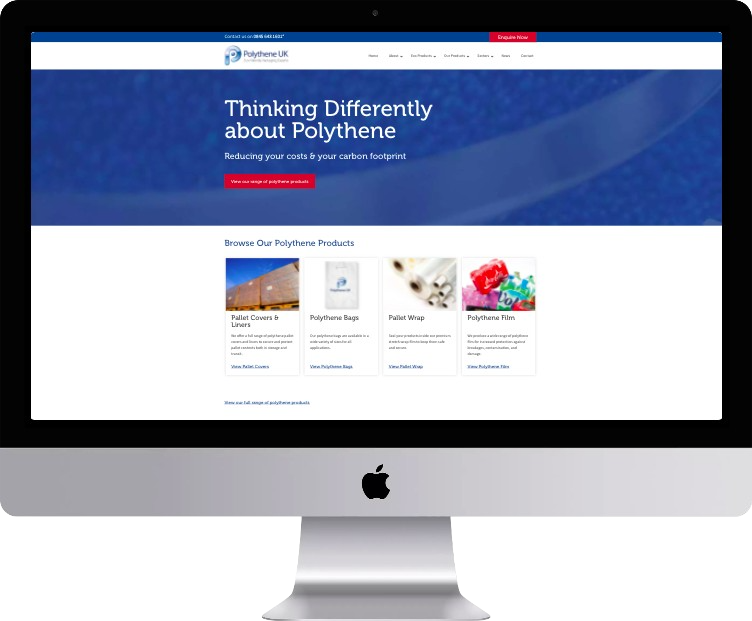Polythene UK
Building links and boosting rankings to deliver traffic and conversions for Polythene UK
Increase in traffic
Increase in domain authority
Increase in conversions
“After 11 years together, we know we can trust Zest to spot those creative, game-changing opportunities and execute on their ideas. We’re thrilled with the results!”
— James Woollard, Managing Director at Polythene UK
Objectives
Polythene UK is the leading independent provider of polythene products in the United Kingdom, delivering a range of polythene bags, films, wraps, covers, and liners to a variety of sectors. They also share our passion for the environment, with many of their products 100% recyclable or compostable.
And as Zest’s longest-standing client (11 years and counting), we’ve been with Polythene UK for almost every step of their epic journey — from early startup to established industry leader.
In that time, many key digital marketing disciplines have evolved, so our techniques have had to evolve along with them. This is especially true of link building, a crucial part of search engine optimisation (SEO).
Our objective: build new links to increase quality search traffic and boost conversions.
Strategy
So, to maintain and grow the strong online presence we’d built for Polythene UK over the years, we encouraged them to invest in a link building campaign centred around a specific product.
But before we explain how we did it, first thing’s first…
-
Put simply, a link is something you click to take you to another web page (or website) on the internet. You can “build” a link by encouraging someone to link to your website from theirs. When this happens, search engines like Google treat the link as a recommendation.
There are two different types of links: dofollow and nofollow.
Dofollow is a link where one website gives its full backing to another. It’s a bit like someone recommending a restaurant where they’ve eaten many times before. You can trust their recommendation because they have first-hand experience.
Nofollow is a link where a website links out to another website, but it doesn’t take any responsibility for that recommendation. This one’s a bit like someone suggesting a restaurant that they’ve heard was good, but they haven’t tried the food yet.
Dofollow links are valuable and sought after because they can help boost search engine rankings — and this value has not gone unnoticed. Earning a dofollow link often requires building personal relationships with other website owners, and can also require payment.
A nofollow link is still valuable (it’s also a recommendation, and it can deliver direct traffic from one website to another), but it doesn’t carry as much clout with search engines.
-
It all comes down to something called “domain authority.”
If, for example, you have a website dedicated to socks, and lots of other websites are linking to your website when they’re writing about socks, Google will consider your website an authority on the subject. As a result, your website will have a high domain authority, which in turn means you’ll rank higher in the search engine results for keywords related to socks.
In other words, trustworthy and highly recommended websites are rewarded by search engines because they know their end-users are more likely to enjoy a good user experience.
But it’s not all about volume when it comes to links.
To illustrate, let’s imagine there are two speeches happening simultaneously, and both are about saving the planet.
The first speech was recommended by Sir David Attenborough, Prof. Brian Cox, and Elon Musk. It’s a must-watch in the eyes of those guys.
Meanwhile, the second speech has hundreds of reviews, but you couldn’t put a name to any of them.
In this scenario, we can reasonably assume the speech with the renowned backers is probably more worthy of our time because of the credibility of those recommending it.
It’s the same online. More isn’t always better — the quality and trustworthiness of the links matter too.
-
A few decades ago, link building was relatively straightforward. You could sign up to a forum, drop a link in the comments, and reap the benefits described above.
But then Google got smarter.
They realised that these low-quality links were manipulating the search results, so they set about punishing “spammy” links while rewarding natural, high-quality web content.
This makes link building in 2022 one of the most labour-intensive SEO tactics.
With this in mind, our general approach to link building looks a little like this:
- Identify link targets (keywords we wish to target, pages we want to push, etc.)
- Identify link opportunities on reputable and related websites
- Reach out to the relevant contact from each website
- Negotiate over the content and link placement
- Create and publish content
- Repeat
Action
We began our link building campaign for Polythene UK by selecting a particular product range to build links to. This is where link building can be incredibly effective, as pointing links at a specific page can help elevate that page in the search results. And with higher rankings comes more traffic and the potential for increased conversions.
We also considered the authority of the sites we were approaching. By ensuring that we were only working with quality websites (and websites Polythene UK would happily associate with online), we could be confident that the links we were building would produce results.
This is particularly important when we’re identifying link building opportunities. We don’t just take a website’s domain authority at face value. We want to understand the amount of traffic it receives, how engaged and relevant its audience is, and if the site’s brand and content fit with our client’s.
Results
By focusing on link quality over quantity, we were able to deliver some eye-catching numbers for Polythene UK:
A 47.5% increase in links (as we mentioned earlier, the number of links doesn’t always enhance authority — it’s all about the quality of links).
This resulted in an 88.9% increase in domain authority (meaning Polythene UK’s website is now considered even more trustworthy in the eyes of the search engines).
And this boost in authority helped deliver a 218.8% increase in traffic.
The best part? The byproduct of increasing domain authority is that the site ranks higher for relevant keywords, which means the site traffic tends to be higher quality, too. And higher-quality traffic often brings an increase in conversions.
The bottom line: our link building efforts on behalf of Polythene UK delivered a whopping 300% increase in conversions!
Growth team
-

Ollie H
Head of Client Services
-

Rachel B
Head of Digital
-

Alex C
Senior PPC Specialist







